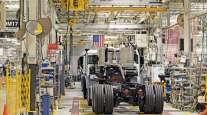UAW Breaks Pattern of Adding Factories to Strikes on Fridays

[Stay on top of transportation news: Get TTNews in your inbox.]
DETROIT — The United Auto Workers union isn’t adding any factories to those that are now on strike, but its president says walkouts could be added at any moment.
Until this week the union had been announcing additional factories on Fridays. But UAW President Shawn Fain told workers in a live video appearance that the companies started gaming the system, waiting until Fridays to make progress in bargaining.
“We will be calling out plants when we need to, where we need to, with little notice,” Fain said Oct. 13. “We’re not sticking to one pattern or one system of giving these companies an extra hour or an extra day. They know what needs to happen and they know how to get it done.”
Fain said the union is still bargaining hard with General Motors and Jeep maker Stellantis. But he criticized Ford, which said Oct. 12 that it had reached the limit of how much money it will spend to settle the strike.
UAW President Shawn Fain Livestream Update 10/13/23 https://t.co/2kOMJaTAjt — UAW (@UAW) October 13, 2023
“I found a pathetic irony in that statement,” Fain said, adding that it’s workers who have reached their limits by not getting raises for a decade and giving up what he called retirement security.
His statements came four weeks after the union began its walkouts against the Detroit automakers on Sept. 15.
The strikes started with one assembly plant from each company. The union later added 38 parts warehouses at GM and Stellantis, and then one assembly factory each from Ford and GM. The UAW then made a surprise move on Oct. 11, adding a huge Ford pickup truck and SUV plant in Kentucky.
About 33,700 workers are on strike against the companies. Analysts say parts supply companies, especially smaller ones without a lot of cash reserves, will be squeezed as the strikes goes on.
The head of Ford’s combustion engine vehicle unit said Oct. 12 that the company had reached its limit for the amount of money it will spend to reach a deal with the union.
Kumar Galhotra, president of Ford Blue, the company’s internal combustion engine business, told reporters Oct. 12 that Ford stretched to get to the offer it now has on the table that includes a 23% pay raise over four years and other benefit increases.
“We have been very clear we are at the limit,” he said on a conference call with reporters. “We risk the ability to invest in the business and profitably grow. And profitable growth is in the best interest of everybody at Ford.”
The company has a set amount of money, but is willing to move dollars around in a way that might fit the union’s needs, Galhotra said, adding that he still thinks it’s possible to reach a deal.
The union began the strike by targeting a small number of plants from each company rather than have all 146,000 UAW members at the automakers go on strike at the same time.
Last week, the union reported progress in the talks and decided not to add any more plants. This came after GM agreed to bring joint-venture electric vehicle battery factories into the national master contract, almost assuring that the plants will be unionized.
Want more news? Listen to today's daily briefing above or go here for more info
Battery plants are a major point of contention in the negotiations. The UAW wants those plants to be unionized to assure jobs and top wages for workers who will be displaced by the industry’s ongoing transition to electric vehicles.
Since the start of the strike, the three Detroit automakers have laid off roughly 4,800 workers at factories that are not among the plants that have been hit by the UAW strikes.
Separate companies that manufacture parts for the automakers are likely to have laid off workers but might not report them publicly, said Patrick Anderson, CEO of the Anderson Economic Group in Lansing, Mich.
A survey of parts supply companies by a trade association called MEMA Original Equipment Suppliers found that 30% of members have laid off workers and that more than 60% expect to start layoffs in mid-October.




